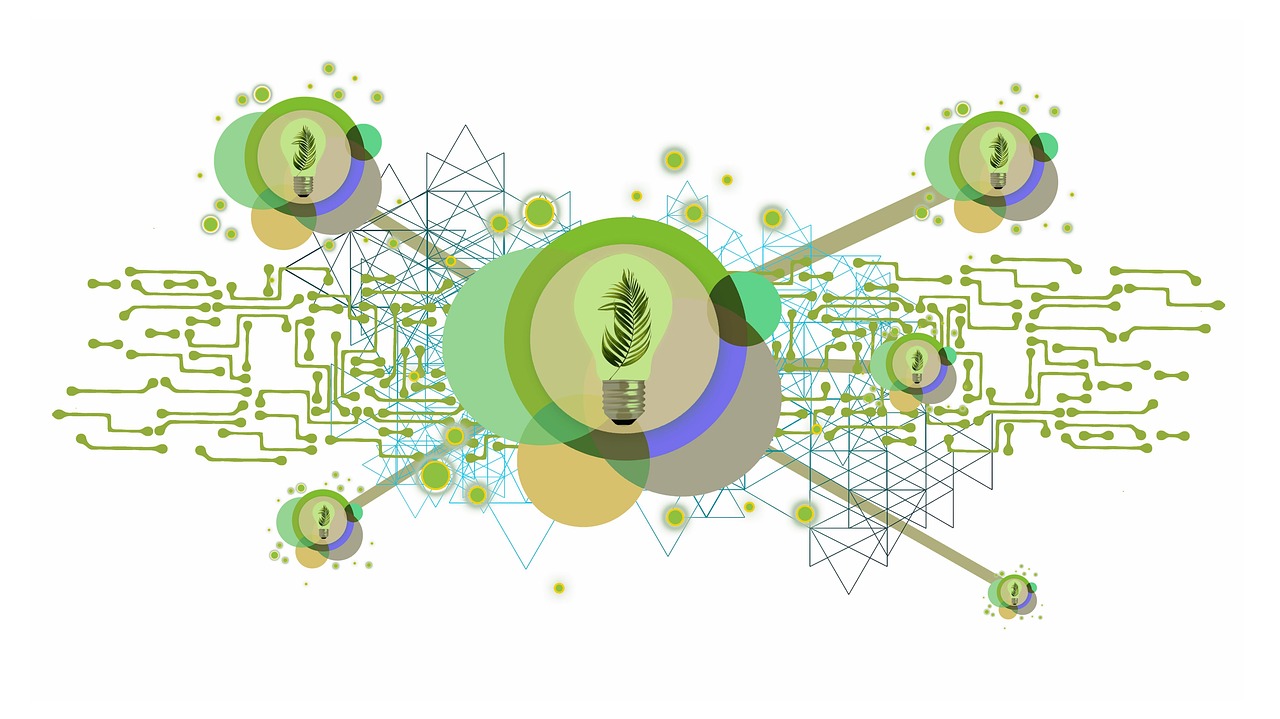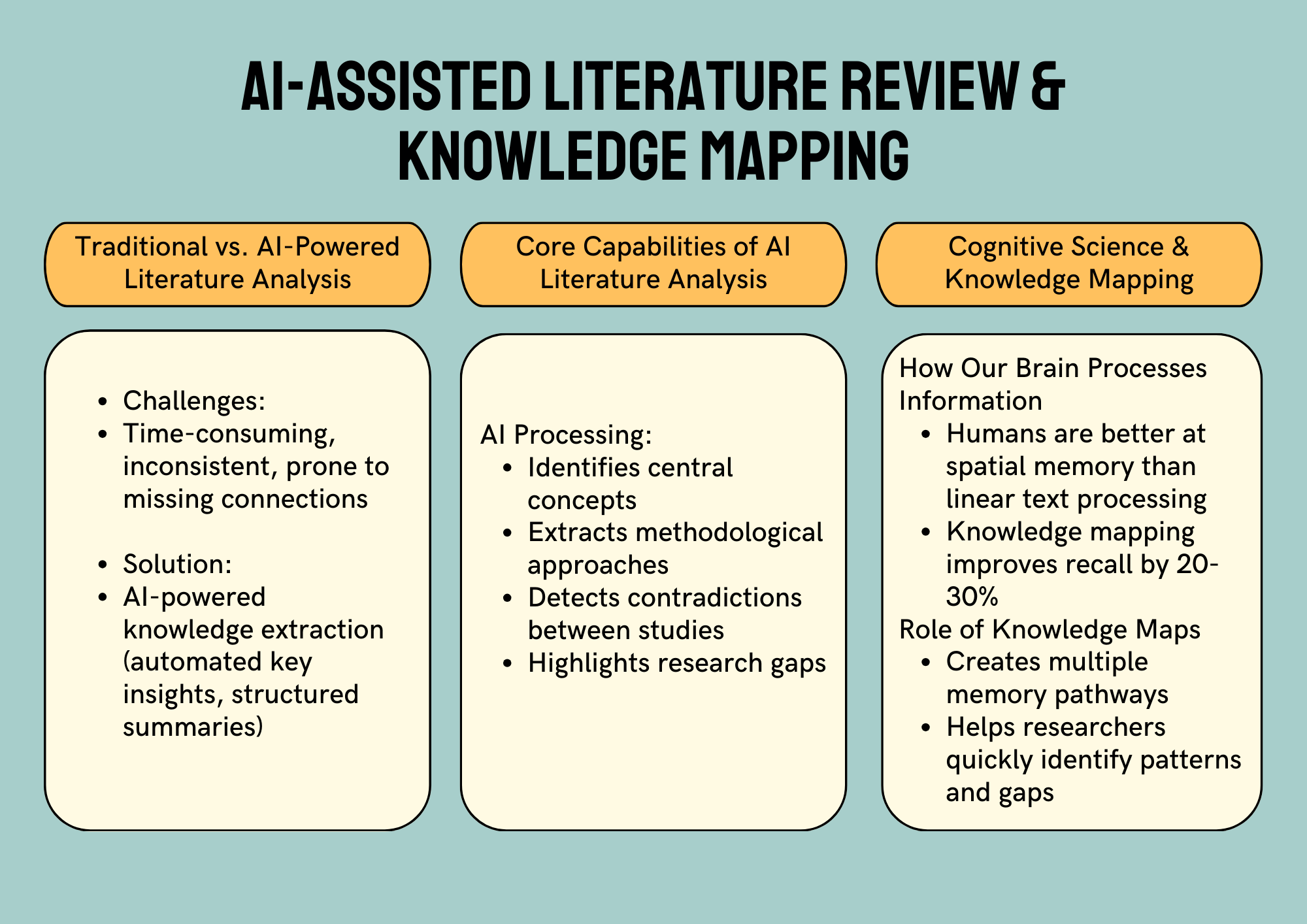
In a world where over 2 million new research papers are published yearly, literature reviews have become a daunting challenge. As a researcher myself, I've felt that sinking feeling when facing hundreds of PDFs with no clear way to connect them. But there's good news: AI-assisted literature review using knowledge maps is changing how we process academic information. Let's explore why this approach is becoming the preferred choice for serious researchers.

The Modern Challenge of Academic Literature Review
Information Overload: When 200+ Million Papers Become Overwhelming
With over 200 million academic papers already published and millions more added yearly, traditional literature review methods simply can't keep up. Even if you spend just 10 minutes on each paper in a modest 100-paper review, that's already 16+ hours of reading time alone—no notes, no analysis, just reading.
"I used to print papers and stack them on my desk," says Dr. James Chen, a neuroscience researcher. "Eventually, I had towers of paper but struggled to remember what connected to what."
The Time Constraints Facing Today's Researchers
Time has become the scarcest resource in academia. Between grant applications, teaching, lab work, and publishing pressures, researchers simply don't have weeks to spend on comprehensive literature reviews anymore.
A 2022 survey found that researchers spend approximately 15 hours weekly just searching and reading literature—time that could be spent on actual experiments or writing. This time crunch often leads to missed connections and duplicated research efforts.
Linear vs. Spatial Thinking in Literature Synthesis
Here's the problem: we read papers linearly (start to finish), but our brains don't think that way. We think in connections, relationships, and spatial associations.
When reviewing 30+ papers on a topic, linear notes create a disconnected collection of information. Our brains naturally want to organize concepts spatially to see how everything fits together. This mismatch between linear reading and spatial thinking creates a major bottleneck in research understanding.
Transforming Research with AI-Assisted Literature Review

From Manual Highlighting to Intelligent Knowledge Extraction
Remember highlighting important passages and scribbling notes in margins? While nostalgic, these methods don't scale to today's research demands.
AI-assisted literature review automatically extracts key concepts, methods, findings, and relationships from papers. This isn't just faster—it ensures consistency across dozens or hundreds of papers, catching connections a tired researcher might miss at 11 PM.
How AI Literature Analysis Accelerates Research Understanding
The acceleration goes beyond simple time savings. AI literature analysis provides:
Immediate identification of central concepts across multiple papers
Automatic extraction of methodological approaches
Recognition of contradictory findings between studies
Visualization of research gaps that need addressing
These capabilities help researchers move from surface skimming to deep understanding in a fraction of the time traditional methods require.
The Cognitive Science Behind Knowledge Mapping for Literature Review
Our brains evolved to navigate physical spaces and remember spatial relationships—not to process pages of linear text. Research shows that spatial arrangement of information improves recall by 20-30% compared to linear formats.
Knowledge maps leverage this natural cognitive preference, creating multiple memory pathways and mirroring how our neural networks actually store connected concepts.
Key Benefits of Map-Based Approaches to Literature Review
Visualizing Connections Across Multiple Research Papers
The most valuable insights often emerge not from individual papers but from the connections between them. Traditional notes make these connections difficult to see, while knowledge maps make them explicit.
With map-based approaches, you can:
Instantly see how concepts from different papers relate
Identify research gaps more easily
Follow idea evolution across multiple publications
Discover unexpected relationships between seemingly unrelated concepts
Building Permanent Knowledge Structures vs. Temporary Notes
Traditional literature reviews often produce ephemeral outputs—notes that get filed away and rarely revisited. Knowledge maps create permanent, extensible structures that grow with your research.
Each new paper you analyze doesn't just add more disconnected notes; it enriches your existing knowledge structure. The result is cumulative understanding rather than isolated insights that fail to connect with previous learning.
Knowledge Retention: Why Spatial Organization Improves Recall
Let's be honest—we forget most of what we read, especially when consuming dozens of papers. Spatial organization dramatically improves retention by creating multiple memory cues.
When information is organized spatially, you remember not just the content but its location and relationships to other concepts. This multi-dimensional encoding significantly improves recall, particularly for complex relationships between ideas.
How ResearchFlow's AI-Assisted Literature Review Differs from Traditional Methods
One-Click Paper Transformation: From PDF to Interactive Knowledge Map
ResearchFlow transforms how researchers process papers. Instead of linear reading, you can convert any research paper into an interactive knowledge map with a single click.
The system intelligently identifies key concepts, methods, findings, and relationships, organizing them into an intuitive spatial layout. What would take hours manually happens in seconds, giving you an immediate framework for understanding each paper's contribution.
Multi-Document Comparison for Comprehensive Literature Analysis
Perhaps the biggest challenge in literature review is comparing approaches across multiple papers. ResearchFlow's multi-document comparison allows you to view similarities and differences between papers side-by-side in map format.
This capability makes it easy to:
Compare methodological approaches across similar studies
Identify contradictory findings that require deeper investigation
Spot gaps where new research could contribute
Create synthesis maps that combine insights from multiple sources
Progressive Learning Flow: From Framework Building to Deep Exploration
ResearchFlow's approach mirrors how researchers naturally build understanding—starting with broad frameworks and progressively diving deeper.
The platform allows you to begin with high-level concept maps capturing key themes, then progressively explore specific connections, contradictions, and nuances. This structured approach prevents getting lost in details before understanding the broader landscape.
AI-Assisted Literature Review Applications in Emerging Research Fields
Accelerating Systematic Reviews in Medical Research
Medical researchers conducting systematic reviews face particularly daunting challenges—often needing to process thousands of papers under strict methodological requirements.
A recent systematic review on COVID-19 treatments used knowledge mapping to process over 2,500 papers in three weeks—a task that would typically take months. The spatial organization helped researchers identify treatment clusters and contradictory findings that might have been missed in traditional linear review.
Interdisciplinary Research: Connecting Ideas Across Domain Boundaries
Today's most important research often happens at the intersection of disciplines, where researchers must bridge different terminology, methods, and knowledge traditions.
Map-based literature review excels here by making conceptual connections visible even when terminology differs. Researchers working across biology and computer science, for example, can map concepts from both fields and visualize relationships that disciplinary language differences might obscure.
How PhD Students Are Revolutionizing Dissertation Literature Reviews
PhD students are among the earliest adopters of AI-assisted literature review tools, using them to transform the dissertation process.
Rather than spending their first doctoral year just reading and taking notes, students using knowledge mapping approaches can create comprehensive literature landscapes in months. This efficiency allows more time for original research while improving the quality of literature reviews.
Implementing AI-Assisted Literature Review in Your Research Workflow
Getting Started: From Paper Collection to Knowledge Mapping
Transitioning to an AI-assisted, map-based literature review approach is straightforward:
Start with 5-10 papers central to your research area
Upload them to ResearchFlow for automatic knowledge extraction
Review the initial maps, adjusting organization as needed
Gradually expand by adding related papers to your knowledge structure
Use the growing map to identify gaps and direct further literature search
This approach creates a cycle where your literature review becomes simultaneously more focused and more comprehensive.
Integration with Traditional Research Methods
AI-assisted literature review doesn't replace traditional methods—it enhances them. Most researchers adopt a hybrid approach:
Use knowledge maps for rapid understanding and connection-building
Deep-read the most essential papers for nuanced understanding
Annotate maps with personal insights and critical analysis
Export structured notes for writing or collaboration
This integration combines AI efficiency with irreplaceable human critical thinking and contextual understanding.
Measuring the Impact: Time Saved and Insights Gained
The benefits of map-based, AI-assisted literature review include:
Time efficiency: Researchers report 60-70% time savings in initial literature processing
Comprehensiveness: Increased confidence in review completeness
Insight quality: More novel connections between concepts
Retention: Better recall of literature content months later
For most researchers, the most valuable outcome isn't just time saved but understanding gained—seeing connections and patterns that might have remained hidden in traditional linear review.
By adopting an AI-assisted, map-based approach to literature review, you're not just keeping up with the information explosion in academia—you're transforming it from an overwhelming challenge into a strategic advantage for your research.